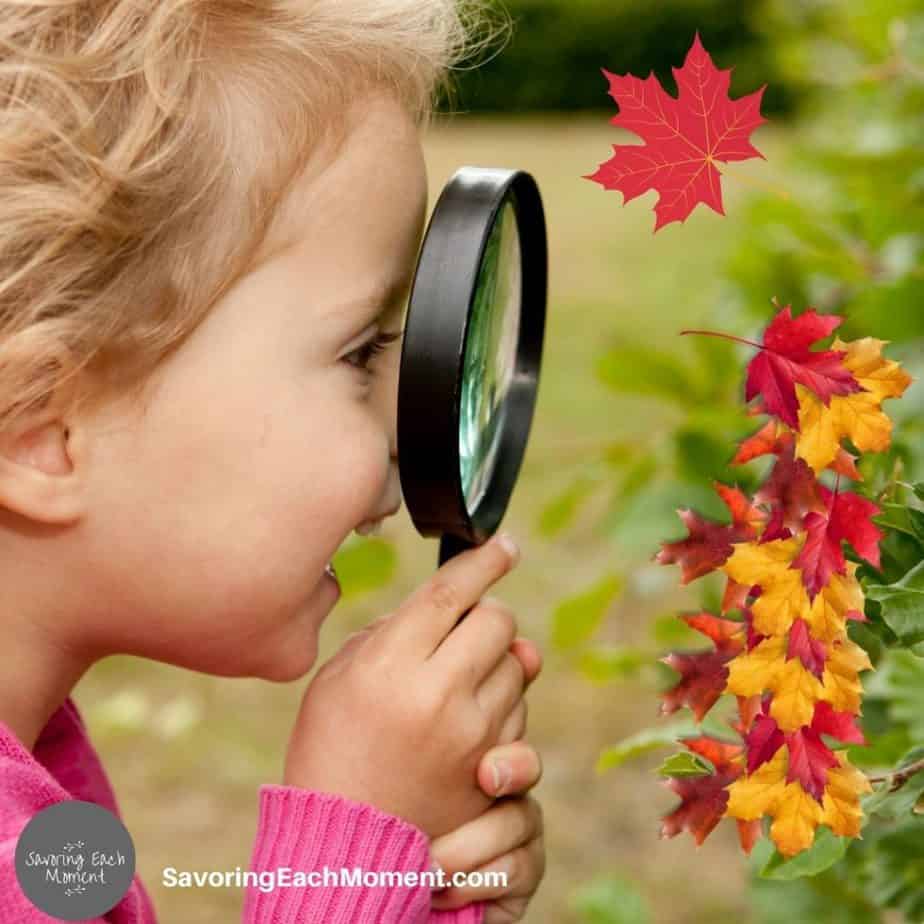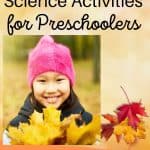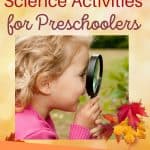Every year as the leaves begin to change colors and the season shifts, it’s a great time to do some fall science activities for preschoolers! Your small children love to explore and learn and the changing season provides the perfect backdrop for different activities.
Talking about fall science activities for preschoolers can sound a bit intimidating and academic, but really, you are just providing your preschool child with opportunities to explore, experience, test, and learn. Most of all, your fall preschool science activities should be a whole lot of fun!
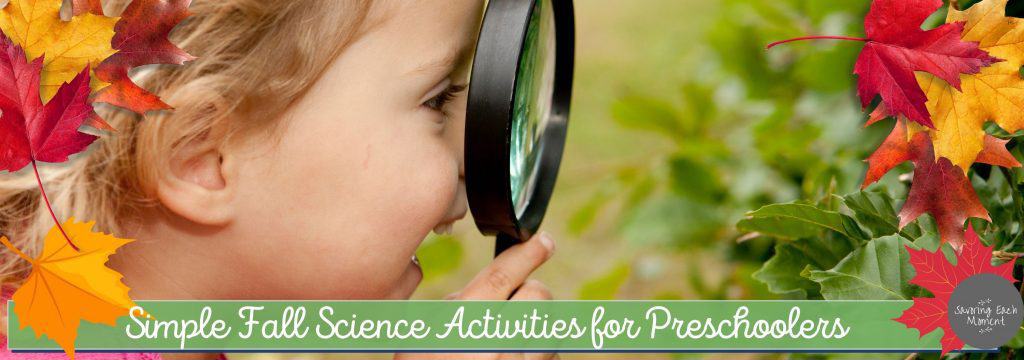
This post may contain affiliate links. That simply means that I may receive a small commission when you purchase something through the link at no additional cost to you.
Indoor Fall Science Activities for Preschoolers
Often, the weather turns rainy or cold and you are stuck in the house. If this is the case where you live, you will want to have some indoor fall science activities for your preschooler to enjoy. There are many fall science activities for preschoolers that you can do inside. It may take a little more planning to have your materials together, but you can still have lots of fun!
Here are some indoor fall science activities for preschoolers. These are just beginning ideas. Once you start looking at activities from a science angle, you will realize you probably already do a lot of things together that you could expand to include science conversations. Toddlers and young children are constantly learning about the world around them and they are seeking new things to figure out, try, experiment with, and learn about.
Measuring: Get out the measuring cups, a funnel, and other small containers and add them to your child’s bathtime. Your preschool child will enjoy measuring, pouring, and exploring the way water (and bubbles for more fun) can flow and move. If you don’t have a bathtub, you can always fill up the kitchen sink and encourage the same exploration.
Growing Food: Make some homegrown sprouts. This project will take a few days but sprouts grow really fast and they are very easy to grow. Alfalfa seeds or mung bean seeds are tasty and usually pretty easy to find at the grocery store or on Amazon. All you need is some seeds and a jar and a little bit of patience. Sprouts are usually ready to eat in 4-5 days so they are fast enough to see the change in how they grow each day.
Growing Plants: Plant some seeds indoors. Another fun way to bring science activities to your preschooler’s life is to use the things that surround you and learn from them. When you eat an apple, talk about the seeds and then plant a few in bowls with dirt. Watch for them to grow. Avocado seeds can also be fun to grow and watch how their roots develop. How to grow an avocado.
Colors and textures: While you’re talking about seeds, why not make a seed/bean picture? Any coloring page from your child’s coloring book could work. The larger, simpler the picture the better. Collect a variety of sizes and colors of beans and seeds and then allow your child to glue the seeds or beans into the different parts of the picture. Some seeds and beans that work really well are green and yellow split peas, lentils, navy beans, black beans, popcorn, rice, etc. Check out the dry bean aisle at your grocery store for ideas for sizes and colors. Note: The picture will take time for the glue to dry and will be heavy when it’s finished. You may want to start with a picture on cardstock or lightweight cardboard.
Produce printing: Fall is a great time to find apples and potatoes. Whether you grow these yourself, pick them from a farm, or buy them at the grocery store, they are usually easy to find. Cut an apple in half from top to bottom or across the middle to get a star shape from the seeds. Then use that half of an apple and dip it in paint and “stamp” the shape on paper or fabric. If you use a potato, you can cut the potato in half and carve a shape out of the cut end. Then use it as a “stamp” as well. This can be a fun project for making wrapping paper for birthdays or the holidays. Talk to your child about the way the shape of the apple or potato is transferred. Look at how the shape is the same and different.
RELATED: 29 Fall Activities for Kids
Leaf Science Activities
- Collect some different shaped leaves and bring them inside for this project. Take a leaf (large or small) and lay it as flat as possible under a piece of clean paper. Then help your child hold a crayon or pencil at an angle so that when they rub the crayon or pencil on the paper (over the leaf) the leaf imprint will show up. Use these pictures to display, send as a card, or give to a friend. As your child is experiencing the “magic” of the leaf shape coming through the page, talk to them about the different types of leaves. Look at their veins and design on the actual leaf. Point your child to God as the Creator and look at the wonderful way He has made each leaf.
- Dry some leafs in a flower press or large book. When they are dry, cut a 12 x 18 inch piece of contact paper. Help your child arrange the dried leaves on the contact paper. When they are satisfied with their masterpiece, take a second sheet of contact paper and place it carefully over the leaves. Now you have a pretty placemat. You can also add a Bible verse or pictures to the placemat before sealing it up.
- Find some large leaves and make cement stepping stones with leaf designs. These are perfect gifts for the holidays. You can find more directions here.
- Collect lots of different colors and shapes of leaves and then help your child create leaf pictures like these.
- Anytime you are crafting, collecting, or decorating with nature, this is a perfect opportunity to add in words like same and different, bigger and smaller, rough and smooth, rounded and jagged and the list goes on. All of these words bring science into your conversation.
Weather station: A common fall preschool science activity is to study the weather. A great way to do this with your child is to create a weather station that you can use to keep track of the weather patterns. Find a clear, narrow, jar or container and mark it with inches to create a rain gauge. Purchase a small outdoor thermometer and hang it up with your rain gauge close to a window or door where your child can see them easily. Help your child keep track of the weather and how much rain you get over the next weeks or months. Help them or show them how to write this information on a calendar so they are learning and keeping track of data. You can also purchase or create a windsock to measure the direction of the wind as well.
Make a squirrel feeder: If you have squirrels or birds outside your home, then creating a feeder to hang up outside can bring a lot of joy throughout the winter months. Wildlife and their behaviors provide all sorts of science conversations for preschool kids. Some of these questions might be about how to birds fly, how do squirrels hang upsidedown, how do they shell the sunflower seeds, etc. You can purchase a kit to make a bird feeder, or you can make one of your own. All you will need is some pinecones, peanut butter, a string, and some birdseed. Smear the peanut butter all over the pinecone and then roll it in birdseed to get it to stick to the peanut butter. Hang it up and enjoy your new little friends outside your window.
Dried flower crafts: Fall is the perfect time to pick those last flowers and leaves and press them. It’s simple to press them to dry if you have an old phone book or simply two sheets of paper that you can slip into a book. Carefully spread out the petals of your flowers and lay them between the two pages. Then set some heavy books on top of them and let them sit for a week or so. Once the flowers are completely dry, carefully lay them on a sheet of clear contact paper and then cover them with a second piece of contact paper. You can make clear placemats, bookmarks, or sun catchers to hang in the window. Some science questions that could come into your conversation could include the parts of the flowers, the size, color, and shape, comparing which flowers press well and which ones don’t and why.
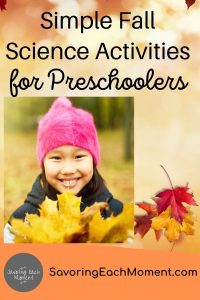
Outdoor Fall Science Activities for Preschoolers
Scavenger hunt: Taking your young children outside in the fall is the perfect backdrop for searching for and finding things in nature. Some of the things you can look for are different colored leaves, different shapes, animal signs (footprints, nests, scat, etc), different types of seeds, colors, shapes, or textures.
RELATED: Listening Walk Scavenger Hunt Bingo Sheets
Dried nature: When you are outside in the fall with your toddler or preschooler, there are so many different natural things that you can dry and use for crafts later. Look for flowers that are still blooming, colored leaves, ferns, or any other interesting shaped plant. Make sure they are safe to touch and okay for you to pick. Then bring the flowers and leaves home and spread them out in your flower press or between the pages of a big book. Place some additional books on top of the book and let the flowers and leaves dry for several days. Once they are dry, you can use them to make bookmarks, placemats, or pictures to hang in your window by placing the flowers carefully between two pieces of clear contact paper.
Walk in the rain: Depending on where you live, you may have windy days, rainy days, or snowy days in the fall. One of the best fall science activities for preschoolers and toddlers is to go hunting for puddles. Children are fascinated by water and the things that might be in the water like worms, sticks, leaves, etc. Put on your rain boots, coat, and hat, and grab your fun umbrella and go find some puddles. Look at the reflections in the water as well. Grab your camera for this one because most likely you’ll have the opportunity for some fun pictures as well.
Fly a kite: Because fall often brings windy days, this is a great time to fly a kite with your preschooler. When you are thinking about fall science activities for preschoolers, you may think that flying a kite is just a sport, but you can encourage your child to explore the wind direction, talk about how the wind changes in directions, and how the kite might go up and down. Check your surroundings for power lines and trees that might interfere with your kite flying experience.
Pumpkins patch fun: If you live near a pumpkin patch, this can be a great opportunity for fall science activities for preschoolers or toddlers. Pull out your jackets and rain boots, and grab your camera for another fun photo opportunity while learning about how pumpkins grow, choosing a pumpkin, and enjoying the other fun activities at the pumpkin patch. When you get home, cut your pumpkin open and let your child scoop out the seeds. Toast them and enjoy, or plant them and watch them grow during the winter.
Apples and science: Fall and apples often go hand in hand. If you happen to live close to an orchard, see if you can find a place where you can pick apples. If you don’t have a picking location, go to the local farmer’s market or grocery store and pick out some of the different colors and sizes of apples. Cut your apple across the middle of the apple opposite of the way you typically cut it from top to bottom and help your child explore the hidden star in the core. Count the seeds. Compare the seeds from different varieties. Make applesauce or apple pie.
RELATED: Learning Through Play
Fun Science Activities for Preschoolers in the Fall
There are so many fun ways to add fall science activities for preschoolers into your fall calendar. These activities don’t have to be expensive and most of them are easy to fit into a small amount of time and require a minimum of supplies. Think about other ways you can use leaves, nuts, and pinecones to create crafts, decorations, or gifts for the holidays.
Pull out your cozy clothes and go find a puddle, or catch some leaves. Help your child learn and explore this fall with some of these simple fall science activities. The best part of each of these fun science activities for young children is that they all include spending time together. Your child will learn so much more and be so much more interested in whatever activity if they see that you are interested as well. They will love learning from you.
Now, go plan a fun fall science activity for your child! 🙂
❣ Sign up to get our weekly email filled with encouragement, ideas, and support for moms raising kids who love Jesus! ❣

